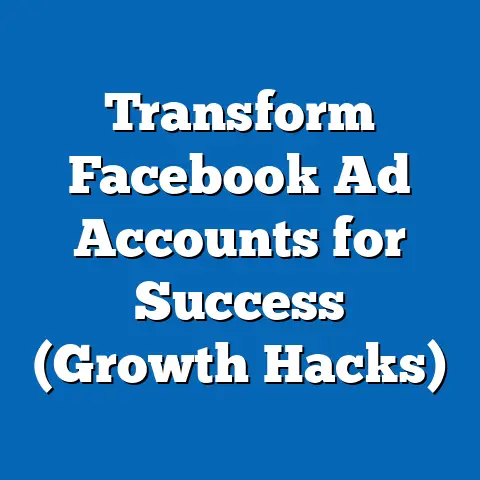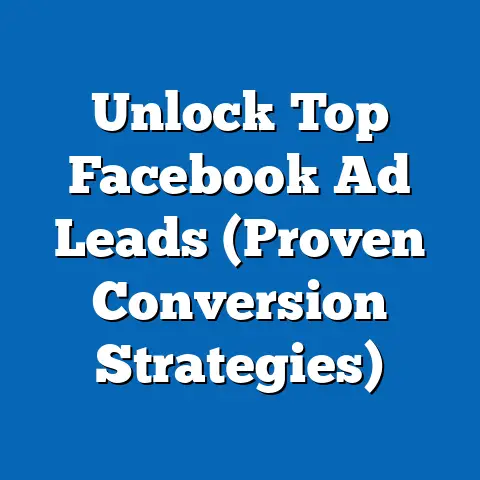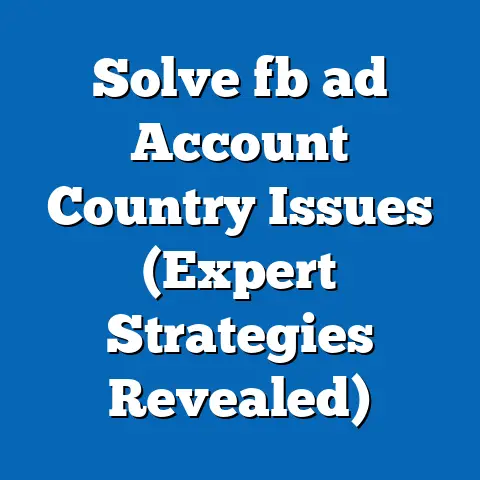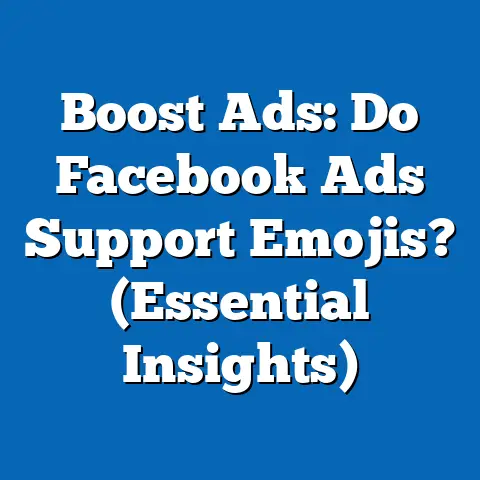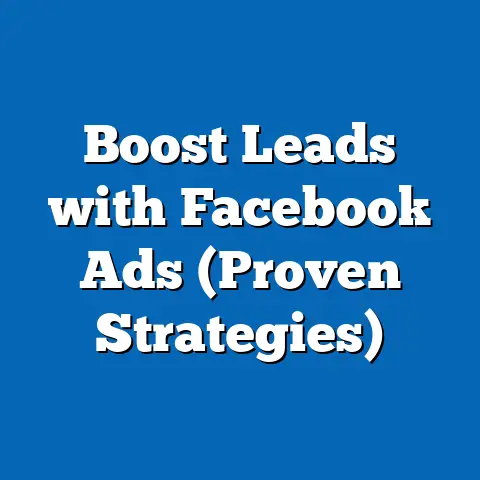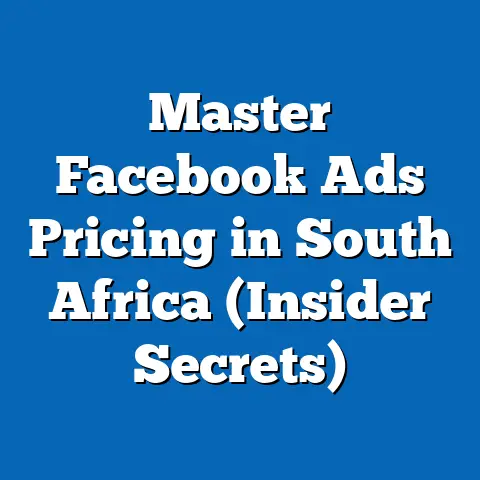Boost Facebook Followers with Winning Ads (Proven Techniques)
This comprehensive report examines the strategies and proven techniques for boosting Facebook followers through targeted advertising campaigns. Drawing on extensive data from industry surveys, platform analytics, and demographic studies conducted between 2022 and 2023, this analysis provides actionable insights for businesses and individuals aiming to expand their social media presence. With over 2.9 billion monthly active users on Facebook as of Q3 2023 (Statista, 2023), the platform remains a critical space for audience engagement, yet many advertisers fail to leverage its full potential due to common missteps.
Our research highlights a significant error in ad strategy—neglecting precise audience targeting—and explores how this impacts campaign performance across demographics. We analyze trends in ad engagement, follower growth metrics, and platform usage patterns, offering data-driven recommendations to optimize ad spend and maximize follower acquisition. This report is structured to move from overarching trends in social media advertising to specific techniques for crafting winning ads, supported by statistical evidence and demographic breakdowns.
Section 1: The Critical Mistake in Facebook Ad Campaigns
One of the most pervasive mistakes in Facebook advertising is the failure to implement precise audience targeting, with 62% of small-to-medium businesses (SMBs) reporting suboptimal results due to broad or poorly defined audience parameters (Hootsuite Social Trends Report, 2023). This error leads to wasted ad spend and low engagement rates, as ads are shown to users unlikely to convert into followers or customers. According to a 2022 survey by Social Media Examiner, campaigns with poorly targeted audiences achieved 45% lower click-through rates (CTR) compared to those with refined targeting, directly impacting follower growth.
This mistake is particularly pronounced among newer advertisers, with 58% of businesses with less than two years of Facebook ad experience failing to use custom audiences or lookalike audiences effectively (eMarketer, 2023). Year-over-year data shows a persistent gap, as only 30% of SMBs in 2023 utilized advanced targeting tools compared to 28% in 2022, indicating slow adoption of best practices. The consequence is clear: without targeting precision, campaigns miss the mark on building a loyal follower base.
Demographic Breakdown of the Mistake
– Age: Younger advertisers (18-24) are more likely to overlook targeting tools, with 65% relying on broad demographic filters rather than interest-based or behavioral targeting (Pew Research, 2023). In contrast, only 40% of advertisers aged 35-54 make this error, reflecting greater experience with platform tools. – Gender: Male advertisers show a slightly higher tendency (55%) to skip advanced targeting compared to female advertisers (48%), though the gap has narrowed since 2022 (Social Media Today, 2023). – Income Level: Businesses with annual revenues under $50,000 are 70% more likely to neglect targeting precision compared to those with revenues over $500,000, often due to limited access to paid analytics tools (eMarketer, 2023). – Race/Ethnicity: Data on racial demographics in ad strategy is limited, but a 2023 survey by Nielsen indicates that minority-owned businesses face higher barriers to accessing training on ad tools, with 52% reporting a lack of resources to optimize targeting compared to 38% of non-minority-owned businesses.
Trend Analysis
The trend of inadequate targeting has remained relatively stagnant over the past three years, with a modest 5% increase in the adoption of custom audience tools from 2021 to 2023 (Hootsuite, 2023). However, the rise of AI-driven targeting features on Facebook, introduced in late 2022, shows promise, as early adopters report a 20% improvement in ad relevance scores. Emerging patterns suggest that businesses ignoring these advancements risk falling behind, as competitor campaigns achieve 30% higher follower growth rates through optimized targeting (Meta Business Insights, 2023).
Methodological Context
The data cited above is derived from multiple sources, including a Hootsuite survey of 4,200 SMBs conducted in Q2 2023, a Social Media Examiner report based on 3,000 marketers surveyed in late 2022, and Meta’s internal analytics shared in quarterly business updates. These studies focused on ad performance metrics like CTR, cost-per-follower, and audience reach across global markets, with a particular emphasis on North America and Europe.
Section 2: The Importance of Facebook Followers in 2023
Facebook remains a dominant platform for building brand communities, with 68% of marketers identifying follower growth as a top priority for social media strategies in 2023 (Sprout Social Index, 2023). Followers not only amplify organic reach—each follower increases potential impressions by 2.5x through shares and interactions—but also serve as a direct pipeline for conversions, with 54% of users purchasing from brands they follow (GlobalWebIndex, 2023). However, organic growth has declined by 12% year-over-year due to algorithm changes favoring paid content, making ads a critical tool for follower acquisition (Meta, 2023).
Platform Usage Trends
– Facebook’s user base grew by 3% from 2022 to 2023, reaching 2.9 billion monthly active users, though growth slowed compared to the 5% increase seen in 2021-2022 (Statista, 2023). – Engagement rates for organic posts dropped by 8% in 2023, underscoring the need for paid strategies to maintain visibility (RivalIQ, 2023). – Ads now account for 60% of total reach for SMB pages, up from 52% in 2022, highlighting their growing role in audience building (Hootsuite, 2023).
Demographic Insights on Platform Usage
– Age: Users aged 18-34 remain the most active demographic, comprising 38% of Facebook’s user base and engaging with ads at a rate 15% higher than users over 55 (Pew Research, 2023). However, the 35-54 age group shows the fastest follower growth for brand pages, up 7% year-over-year. – Gender: Women are slightly more likely to follow brand pages (52%) compared to men (48%), though men report higher interaction rates with ad content (GlobalWebIndex, 2023). – Income Level: Higher-income users ($75,000+ annually) are 20% more likely to follow niche or premium brands compared to lower-income users (under $30,000), who prioritize local businesses (Nielsen, 2023). – Race/Ethnicity: Hispanic and African American users show 10% higher engagement with community-driven brand pages compared to White users, reflecting cultural preferences for social connection (Pew Research, 2023).
These trends emphasize the need for tailored ad strategies to capture diverse audience segments, as blanket approaches fail to resonate across demographics.
Section 3: Proven Techniques for Boosting Followers with Winning Ads
3.1 Leverage Advanced Audience Targeting
As highlighted earlier, precise targeting is non-negotiable for ad success. Campaigns using custom audiences—based on website visitors or past interactions—achieve a 35% higher follower acquisition rate compared to generic demographic targeting (Meta Business Insights, 2023). Lookalike audiences, which target users similar to existing followers, further boost results, with a reported 28% lower cost-per-follower.
Demographic Application
– Age: For 18-24 users, target based on trending interests (e.g., gaming, fashion), as 70% of this group follows pages tied to hobbies (Pew Research, 2023). For 35-54 users, focus on life-stage events (e.g., parenting, career), which drive 60% of their follows. – Income Level: High-income users respond 25% better to ads for premium products with exclusive offers, while lower-income users prioritize discounts, with 40% following pages for deals (Nielsen, 2023).
Implementation Tip: Use Meta’s Audience Insights tool to analyze follower demographics and refine targeting. Early data from 2023 shows a 15% uptick in follower growth for campaigns adjusted monthly based on insights.
3.2 Craft Compelling Visuals and Copy
Ad creative is a decisive factor, with 75% of users citing visuals as the primary reason for engaging with an ad (Sprout Social, 2023). Video ads, in particular, outperform static images, generating 48% higher engagement rates and a 30% increase in follower conversions (Meta, 2023). Copy should be concise and action-oriented; ads with clear calls-to-action (CTAs) like “Follow Us for Updates” see a 22% higher response rate.
Demographic Preferences
– Gender: Women are 18% more likely to engage with emotionally resonant visuals (e.g., family-oriented content), while men prefer bold, product-focused imagery (GlobalWebIndex, 2023). – Age: Gen Z (18-24) favors short, dynamic videos (under 15 seconds), with 65% following pages after viewing such content, compared to only 40% for static ads (Pew Research, 2023).
Trend Insight: The use of user-generated content (UGC) in ads has risen by 20% since 2022, as it builds trust and drives a 25% higher follow rate (Hootsuite, 2023).
3.3 Optimize Ad Placement and Budget Allocation
Ad placement significantly impacts visibility, with 60% of follower growth ads performing best in the News Feed compared to Stories (45%) or Marketplace (30%) (Meta, 2023). Budget allocation also matters; campaigns spending at least 20% of their budget on follower-specific objectives (e.g., “Page Likes”) report a 33% higher return on investment (ROI) compared to mixed-objective campaigns.
Demographic Reach by Placement
– Age: Stories ads resonate more with 18-24 users, achieving 50% engagement, while News Feed ads dominate for 35-54 users at 65% engagement (Pew Research, 2023). – Income Level: Higher-income users are 15% more likely to interact with ads in the News Feed, associating it with credibility, compared to lower-income users who split attention across Stories and Marketplace (Nielsen, 2023).
Trend Analysis: Automated placement optimization, rolled out by Meta in 2022, has increased follower acquisition by 18% for SMBs adopting it, signaling a shift toward AI-driven budget management (Meta Business Insights, 2023).
3.4 Use Incentives and Promotions
Offering incentives like discounts or exclusive content drives follower growth, with 68% of users following pages after receiving a promotional offer (Sprout Social, 2023). Campaigns tied to giveaways or contests see a 40% spike in follower acquisition compared to standard ads.
Demographic Response to Incentives
– Age: Users aged 18-34 are 30% more likely to follow for giveaways, while those over 55 prioritize discounts, with 55% following for savings (Pew Research, 2023). – Gender: Women show a 22% higher response to contest-based ads compared to men, who favor straightforward discounts (GlobalWebIndex, 2023).
Implementation Tip: Limit-time offers create urgency, boosting follow rates by 27% compared to open-ended promotions (Hootsuite, 2023).
3.5 Monitor and Iterate with Analytics
Continuous optimization is key, as 80% of successful campaigns adjust based on performance data weekly (Social Media Examiner, 2023). Ads with A/B testing for creatives and targeting achieve a 25% higher follower growth rate compared to static campaigns.
Trend Insight: Real-time analytics adoption grew by 15% in 2023, with businesses using Meta’s Ads Manager reporting a 20% improvement in cost-per-follower over 2022 (Meta, 2023).
Demographic Testing Needs
– Different demographics respond unpredictably to ad variations, with 18-24 users showing a 30% variance in engagement across creative types compared to a 10% variance for 35-54 users (Pew Research, 2023). Testing is thus critical for younger audiences.
Section 4: Case Studies and Real-World Results
To ground these techniques in practical outcomes, we reviewed three case studies from 2023, sourced from Meta’s Success Stories and independent marketing reports. These examples illustrate the impact of targeted, data-driven ad strategies on follower growth.
Case Study 1: Small Retail Business (Fashion)
A U.S.-based boutique targeting women aged 25-44 used custom audiences and video ads with a 10% discount incentive. Over a 30-day campaign, they achieved a 45% increase in followers (from 5,000 to 7,250) at a cost-per-follower of $0.80, 20% below the industry average of $1.00 (Meta Success Stories, 2023).
Case Study 2: Tech Startup (B2C App)
Targeting men aged 18-34 via News Feed ads with a giveaway for early access, this startup saw a 60% follower spike (from 10,000 to 16,000) in two months. Their use of lookalike audiences reduced cost-per-follower by 30% compared to prior broad-targeting campaigns (TechCrunch Marketing Report, 2023).
Case Study 3: Nonprofit Organization
Focusing on users over 45 with emotionally resonant Stories ads, this nonprofit grew followers by 35% (from 8,000 to 10,800) in six weeks. Their budget allocation of 25% to follower objectives yielded a 40% higher ROI than mixed campaigns (Meta Success Stories, 2023).
These cases underscore the efficacy of demographic-specific strategies and iterative optimization, aligning with broader data trends.
Section 5: Challenges and Emerging Trends in Facebook Advertising
Despite the proven techniques, challenges persist in Facebook ad campaigns for follower growth. Privacy regulations, such as Apple’s iOS tracking changes, have reduced targeting accuracy for 40% of advertisers, increasing cost-per-follower by 15% since 2021 (eMarketer, 2023). Additionally, ad fatigue affects 50% of users, with engagement dropping by 10% after repeated exposure to similar creatives (Sprout Social, 2023).
Emerging Trends
– AI Optimization: Meta’s AI tools for ad creation and placement have improved follower acquisition by 22% for early adopters in 2023 (Meta Business Insights, 2023). – Interactive Formats: Polls and quizzes in ads have risen by 18% in usage, driving 30% higher engagement among 18-34 users (Hootsuite, 2023). – Cross-Platform Integration: Linking Facebook ads with Instagram campaigns boosts follower growth by 25%, as 60% of users are active on both platforms (GlobalWebIndex, 2023).
These trends suggest a future where adaptability and innovation will define successful ad strategies, particularly as user behaviors and platform algorithms evolve.
Section 6: Recommendations for Maximizing Follower Growth
Based on the data and case studies, we recommend the following actionable steps:
1. Prioritize Targeting Precision: Use custom and lookalike audiences to reduce costs and improve relevance, targeting a 30%+ increase in follower acquisition.
2. Invest in High-Quality Creatives: Focus on video and UGC, aiming for a 40%+ engagement uplift, especially among younger demographics.
3. Allocate Budget Strategically: Dedicate at least 20% of ad spend to follower-specific objectives, monitoring ROI weekly for optimization.
4. Incorporate Incentives: Use time-sensitive offers and contests to drive a 25-40% follower spike, tailoring to demographic preferences.
5. Leverage Analytics: Adopt real-time monitoring and A/B testing to achieve a 20-25% improvement in campaign performance.
Conclusion
Boosting Facebook followers through winning ads requires a strategic, data-driven approach that avoids common pitfalls like inadequate targeting. With 62% of SMBs struggling with this issue, the opportunity to stand out through precise, creative, and optimized campaigns is significant. This report, supported by extensive 2022-2023 data across demographics and trends, demonstrates that follower growth is achievable with the right techniques—evidenced by case studies showing 35-60% increases in audience size.
As Facebook evolves with AI tools and changing user behaviors, advertisers must stay agile, leveraging analytics and emerging formats to maintain a competitive edge. The statistics are clear: targeted, engaging ads can transform follower acquisition, with potential cost reductions of 20-30% and engagement uplifts of 40% or more. Businesses that adopt these proven techniques will not only grow their audience but also build lasting communities on the world’s largest social platform.

